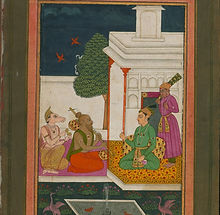Raga
In describing a Rāga, the following aspects hold fundamental importance:
1. The name
2. The Āroha and Avaroha (ascending and descending movements)
3. The Ṭhāṭa (musical scale)
4. The Laya (tempo), indicating whether it is slow, intermediate, or fast
5. Whether the aesthetic value is expressed in the Purvāṁga or Uttaraṁga (lower or upper tetrachord)
6. The Vādī, also called Aṁśa (dominant note)
7. The Graha, specifying the opening and concluding notes
8. The section of the scale that must prevail
9. The Jāti, indicating whether it is Sampūrṇa, Ṣāḍava, or Auḍuva (heptatonic, hexatonic, or pentatonic)
10. Classification based on the criteria of Ṥuddha, Sālaṅka or Chāyālaga, Saṁkīrṇa (pure, mixed, or blended)
11. The Calana (progression), indicating whether it is Ṥuddha or Vakra (regular or irregular)
12. Exhibition time, specifying the season or time as appropriate
13. The Pakaḍa, a short phrase useful for immediately recognizing the Rāga, following the principle of 'Rañjayati Iti Rāgah'.
According to the Saṁgītaratnākara, the term Rāga has two meanings:
1. The sound produced through the Svaras (notes), forming a cluster of notes that attract the listener's mind.
2. The sound produced through the Svaras and Varṇas, which attract people's minds.
This definition emphasizes the unique arrangement and interrelation of notes, distinct from compositional harmony, contributing to the aesthetic enjoyment of the listener. The Indian classical music system has created countless Rāgas through precise rules governing composition, juxtaposition, and interrelation of notes.
The ten Ṭhāṭas are recognized, serving as a foundation for creating various Rāgas. The Jāti system classifies Rāgas based on the number of notes used (Sampūrṇa, Ṣāḍava, Auḍuva). The purity classification distinguishes between Ṥuddha, Sālaṅka or Chāyālaga, and Saṁkīrṇa Rāgas.
Paṇdit Viṣṇunārāyaṇa Bhātakhaṇḍe's classification criteria include the number of notes used, the presence of Vādī, and the time of day or year for exposition. Additionally, Rāgas are grouped based on their psychological impact, Ma's nature, and moments of the day or night.
The concept of Goṣṭī reflects the sentimental nature of Rāgas within a group, not necessarily governed by identical notes. Some principal Rāgas include:
Kānhaḍā
Mālakauśa
Kāfī
Malaśrī
Kāmoda
Megha
Khamāj
Lalita
Gauḍa Sāraṅga
Ṥaṅkarā
Naṭa
Ṥuddha Kalyāṇa
Vṛndāvanīsāraṅga
Ṥuddha Malhāra
Bilāvala
Śrī
Bihāga
Sindhu
Bhairava
Hindola
The ideal time for executing Rāgas is classified based on the time of day, season, and psychological impact. This classification helps evoke the intended mood and aesthetic experience for both the musician and the listener.
Moments of the day:
(1) Dawn
(2) Early morning
(3) Late morning
(4) Early afternoon
(5) Sunset
(6) Evening
(7) Night
(8) Late at night
The moments of the day are classified as follows in a list of Rāgas ordered according to the time of day, widely accepted by the Seniyā Gharāna and much of the musicological community:
- 4:00-5:30 AM: Vasanta, Paraja, Sohanī, Lalita, Pañcama, Bhāṭiyāra, Vibhāsa, Bhākāra
- 5:30-7:00 AM: Megharañjanī, Vibhāsa, Jogiyā, Kālīṁgaḍā, Prabhāta, Rāmakalī, Guṅakalī or Guṅakarī, Bhairava
- 7:00-10:00 AM: Hindola, Malaśrī, Gauḍasāraṅga
- 10:00-11:30 AM: Āsāvarī, Bhairavī, Toḍī, Jaunapurī, Kaṭa, Deśī
- 11:30 AM-1:00 PM: Sūhā, Sughrāī, Devaśāśkha, Sāraṅga
- 1:00-4:00 PM: Haṁsakiṁkiṇī, Paṭamañjarī, Pradīpikā, Dhāni, Bhīmapalāśrī, Dhanāśrī, Pīlū, Multāni
- 4:00-5:30 PM: Pūravī, Puriyā, Dhanāśrī, Jayaśrī, Revā, Śrī, Triveṇī, Taṁka, Mālavī, Gaurī
- 5:30-7:00 PM: Puriyā, Māravā, Jayet, Mālīgaurā, Sājagiri, Varāṭī
- 7:00-10:00 PM: Yamana, Bhūpālī, Ṥuddha, Kalyāṇa, Jayet Kalyāṇa, Candrakānta, Hamīra, Kāmoda, Syāma, Chāyānaṭa, Bihāga, Hemakalyāṇa, Naṭa, Maluhā, Ṥaṅkarā, Durgā, Māṁḍ, Pahāḍī
- 10:00-11:30 PM: Khamāj, Jhiṁjhoṭī, Tilaṁga, Khambāvatī, Durgā, Rāgeśrī, Gārā, Suraṭha, Deśa, Tilaka Kāmoda, Jayajayantī
- 11:30 PM-1:00 AM: Kāfī, Saindhavī, Sindhūrā, Bāgeśrī, Bahār, Ṥahāna, Megha, Malhāra
- 1:00-4:00 AM: Darbārīkānhaḍā, Aḍāṇā, Nāyakīkānhaḍā, Kauśika Kānhaḍā, Mālakauśa
INDIAN CLASSICAL MUSIC LESSONS AND ONLINE COURSES
IN MODAL MUSIC, IMPROVISATION AND COMPOSITION
LEARN THE MAIN TECHNIQUES OF INDIAN MUSIC WITH A SIMPLE AND PERSONALIZED METHOD!
My online music lessons are the perfect way to learn to sing, or improve the vocal techniques already acquired, or to start playing your favorite instrument or progress in your musical path through an alternative teaching method to Western teaching.
The goal of my Indian classical music courses is to teach you the basics of this wonderful art form. You will learn about the various Ragas, or modal scales, the Talas or rhythmic cycles, and the vocal and instrumental techniques used for improvisation in Indian classical music.
What makes my approach to teaching indian classical music so distinctive?
My teaching system is obviously unique and different from others and I think that learning music following the traditional Indian approach is the most effective method regardless of genre: pop, jazz, world fusion, electronic, whatever musical style you if you are interested, I guarantee that thanks to the Indian perspective, you will have an edge over all the other musicians.
What will you learn?
During my lessons I use a variety of techniques and exercises to learn to improvise and compose. What you will learn in my Indian classical music courses will be based on the concepts of modal scale and rhythmic cycle, i.e. Raga and Tala. You will also learn vocal and instrumental techniques which, although based on Indian musical theory, also find application in the Western musical system.
Will the course suit you?
My courses are aimed to all musicians of all levels, beginners, intermediate and advanced, offering different study materials and techniques from the usual Western standards. All those who want to learn to play Indian classical music are welcome and no previous knowledge or experience is necessary to get started.
I can not wait to get to know you!
Contact me now! The first lesson is FREE!











%2018th-19th%20centuries%20b.jpg)




